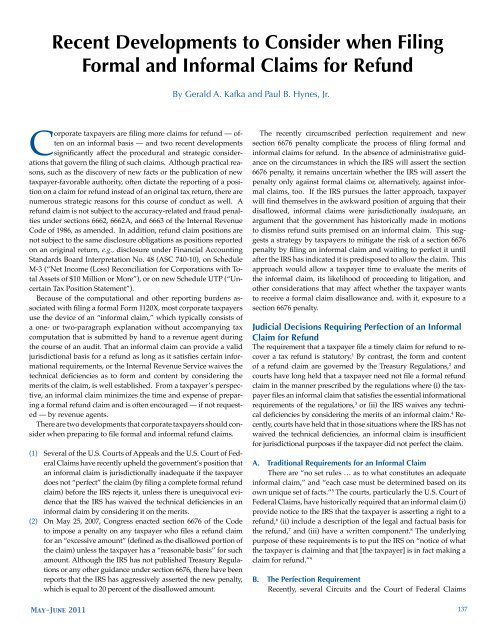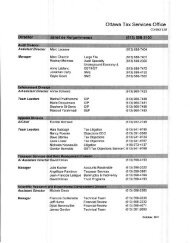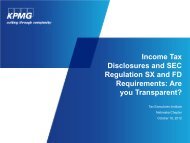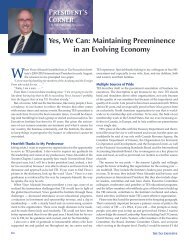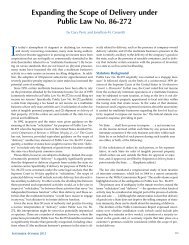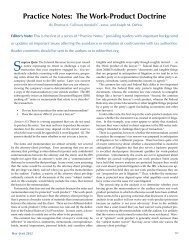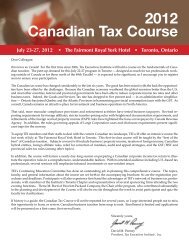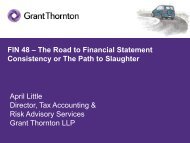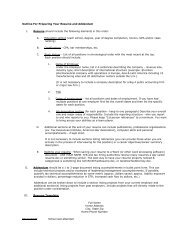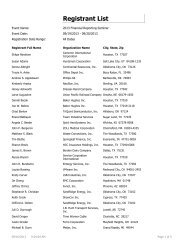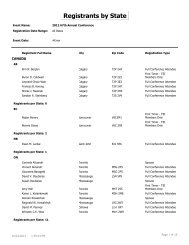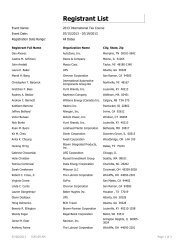recent Developments to Consider when Filing Formal and Informal ...
recent Developments to Consider when Filing Formal and Informal ...
recent Developments to Consider when Filing Formal and Informal ...
You also want an ePaper? Increase the reach of your titles
YUMPU automatically turns print PDFs into web optimized ePapers that Google loves.
Recent <strong>Developments</strong> <strong>to</strong> <strong>Consider</strong> <strong>when</strong> <strong>Filing</strong><strong>Formal</strong> <strong>and</strong> <strong>Informal</strong> Claims for RefundBy Gerald A. Kafka <strong>and</strong> Paul B. Hynes, Jr.Corporate taxpayers are filing more claims for refund — oftenon an informal basis — <strong>and</strong> two <strong>recent</strong> developmentssignificantly affect the procedural <strong>and</strong> strategic considerationsthat govern the filing of such claims. Although practical reasons,such as the discovery of new facts or the publication of newtaxpayer-favorable authority, often dictate the reporting of a positionon a claim for refund instead of an original tax return, there arenumerous strategic reasons for this course of conduct as well. Arefund claim is not subject <strong>to</strong> the accuracy-related <strong>and</strong> fraud penaltiesunder sections 6662, 6662A, <strong>and</strong> 6663 of the Internal RevenueCode of 1986, as amended. In addition, refund claim positions arenot subject <strong>to</strong> the same disclosure obligations as positions reportedon an original return, e.g., disclosure under Financial AccountingSt<strong>and</strong>ards Board Interpretation No. 48 (ASC 740-10), on ScheduleM-3 (“Net Income (Loss) Reconciliation for Corporations with TotalAssets of $10 Million or More”), or on new Schedule UTP (“UncertainTax Position Statement”).Because of the computational <strong>and</strong> other reporting burdens associatedwith filing a formal Form 1120X, most corporate taxpayersuse the device of an “informal claim,” which typically consists ofa one- or two-paragraph explanation without accompanying taxcomputation that is submitted by h<strong>and</strong> <strong>to</strong> a revenue agent duringthe course of an audit. That an informal claim can provide a validjurisdictional basis for a refund as long as it satisfies certain informationalrequirements, or the Internal Revenue Service waives thetechnical deficiencies as <strong>to</strong> form <strong>and</strong> content by considering themerits of the claim, is well established. From a taxpayer’s perspective,an informal claim minimizes the time <strong>and</strong> expense of preparinga formal refund claim <strong>and</strong> is often encouraged — if not requested— by revenue agents.There are two developments that corporate taxpayers should consider<strong>when</strong> preparing <strong>to</strong> file formal <strong>and</strong> informal refund claims.(1) Several of the U.S. Courts of Appeals <strong>and</strong> the U.S. Court of FederalClaims have <strong>recent</strong>ly upheld the government’s position thatan informal claim is jurisdictionally inadequate if the taxpayerdoes not “perfect” the claim (by filing a complete formal refundclaim) before the IRS rejects it, unless there is unequivocal evidencethat the IRS has waived the technical deficiencies in aninformal claim by considering it on the merits.(2) On May 25, 2007, Congress enacted section 6676 of the Code<strong>to</strong> impose a penalty on any taxpayer who files a refund claimfor an “excessive amount” (defined as the disallowed portion ofthe claim) unless the taxpayer has a “reasonable basis” for suchamount. Although the IRS has not published Treasury Regulationsor any other guidance under section 6676, there have beenreports that the IRS has aggressively asserted the new penalty,which is equal <strong>to</strong> 20 percent of the disallowed amount.The <strong>recent</strong>ly circumscribed perfection requirement <strong>and</strong> newsection 6676 penalty complicate the process of filing formal <strong>and</strong>informal claims for refund. In the absence of administrative guidanceon the circumstances in which the IRS will assert the section6676 penalty, it remains uncertain whether the IRS will assert thepenalty only against formal claims or, alternatively, against informalclaims, <strong>to</strong>o. If the IRS pursues the latter approach, taxpayerwill find themselves in the awkward position of arguing that theirdisallowed, informal claims were jurisdictionally inadequate, anargument that the government has his<strong>to</strong>rically made in motions<strong>to</strong> dismiss refund suits premised on an informal claim. This suggestsa strategy by taxpayers <strong>to</strong> mitigate the risk of a section 6676penalty by filing an informal claim <strong>and</strong> waiting <strong>to</strong> perfect it untilafter the IRS has indicated it is predisposed <strong>to</strong> allow the claim. Thisapproach would allow a taxpayer time <strong>to</strong> evaluate the merits ofthe informal claim, its likelihood of proceeding <strong>to</strong> litigation, <strong>and</strong>other considerations that may affect whether the taxpayer wants<strong>to</strong> receive a formal claim disallowance <strong>and</strong>, with it, exposure <strong>to</strong> asection 6676 penalty.Judicial Decisions Requiring Perfection of an <strong>Informal</strong>Claim for RefundThe requirement that a taxpayer file a timely claim for refund <strong>to</strong> recovera tax refund is statu<strong>to</strong>ry. 1 By contrast, the form <strong>and</strong> conten<strong>to</strong>f a refund claim are governed by the Treasury Regulations, 2 <strong>and</strong>courts have long held that a taxpayer need not file a formal refundclaim in the manner prescribed by the regulations where (i) the taxpayerfiles an informal claim that satisfies the essential informationalrequirements of the regulations, 3 or (ii) the IRS waives any technicaldeficiencies by considering the merits of an informal claim. 4 Recently,courts have held that in those situations where the IRS has notwaived the technical deficiencies, an informal claim is insufficientfor jurisdictional purposes if the taxpayer did not perfect the claim.A. Traditional Requirements for an <strong>Informal</strong> ClaimThere are “no set rules … as <strong>to</strong> what constitutes an adequateinformal claim,” <strong>and</strong> “each case must be determined based on itsown unique set of facts.” 5 The courts, particularly the U.S. Court ofFederal Claims, have his<strong>to</strong>rically required that an informal claim (i)provide notice <strong>to</strong> the IRS that the taxpayer is asserting a right <strong>to</strong> arefund, 6 (ii) include a description of the legal <strong>and</strong> factual basis forthe refund, 7 <strong>and</strong> (iii) have a written component. 8 The underlyingpurpose of these requirements is <strong>to</strong> put the IRS on “notice of whatthe taxpayer is claiming <strong>and</strong> that [the taxpayer] is in fact making aclaim for refund.” 9B. The Perfection RequirementRecently, several Circuits <strong>and</strong> the Court of Federal ClaimsMay-June 2011 137
...<strong>Formal</strong> <strong>and</strong> <strong>Informal</strong> Claims for Refundhave held that, in addition <strong>to</strong> the above requirements, a taxpayermust perfect an informal claim after the lapse of the statu<strong>to</strong>ry periodbut before the IRS has rejected the claim. A taxpayer perfects aninformal claim by filing a “formal claim that remedie[s] any defectsin the informal claim.” 10 The principal cases may be summarized inchronological order, as follows:• Fifth Circuit. In PALA, Inc. Empl. Profit Sharing Plan <strong>and</strong> TrustAgreement v. United States, the Fifth Circuit held that the taxpayer’sletter <strong>to</strong> the IRS, which provided “ample notice” of a right<strong>to</strong> a refund, did not constitute an informal claim in part becauseit “was not subsequently amended by a formal claim.” 11• Eighth Circuit. After stating that an “informal claim … musthave been followed by a formal claim that remedied any defectsin the informal claim,” the Eighth Circuit found that thetaxpayers in Kaffenberger v. United States properly perfectedtheir informal claim (which had been made on an au<strong>to</strong>maticextension request directing the IRS <strong>to</strong> apply a refund of theirestimated tax overpayments for the tax year in question <strong>to</strong> thesubsequent year) by filing a late original return (which wasprepared by the IRS) for the tax year in question. 12• Ninth Circuit. Finding “no evidence that [the taxpayer] madea technically-deficient claim within the statu<strong>to</strong>ry period,” theNinth Circuit stated in Commissioner v. Ewing that “any suchinformal claim ‘must have been followed by a formal claimthat remedied any defects in the informal claim.’” 13• Seventh Circuit. In Greene-Thapedi v. United States, a pro se taxpayersued for refund of a 1999 overpayment that the IRS hadapplied against a 1992 tax liability, <strong>and</strong> after the district courtheld that “her Tax Court petition concerning her 1992 taxes …<strong>and</strong> the refund claim for her 1999 overpayment” constituteda “sufficient informal claim for refund of her 1992 overpayment,”the Seventh Circuit reversed on the ground that thetaxpayer’s “subsequent failure <strong>to</strong> file a formal claim barred thecourt from exercising any jurisdiction over the claim.” 14• Court of Federal Claims. Although the taxpayer’s facsimiletransmittal <strong>and</strong> telephone conversations with the IRS in Pennoniv. United States “were sufficient <strong>to</strong> meet the criteria foran informal claim,” the Court of Federal Claims held that it“lack[ed] subject matter jurisdiction <strong>to</strong> consider his claim” because“the [taxpayer] failed <strong>to</strong> perfect his informal claim for arefund by filing a formal claim with the IRS.” 15District courts in the Second <strong>and</strong> Fourth Circuits have likewiseheld that a taxpayer must perfect an informal claim. 16The courts have relied on three principal grounds for requiringperfection. First, the courts have cited Kales v. United States,the seminal case on informal claims, in which the Supreme Courtstated:This Court, applying the statute <strong>and</strong> regulations, has oftenheld that a notice fairly advising the Commissioner of the natureof the taxpayer’s claim, which the Commissioner couldreject because <strong>to</strong>o general or because it does not comply withthe formal requirements of the statute <strong>and</strong> regulations, willnevertheless be treated as a claim, where formal defects <strong>and</strong> lackof specificity have been remedied by amendment filed after the lapseof the statu<strong>to</strong>ry period. 17The lower courts have observed that “the Supreme Court hasendorsed informal claims … as long as a valid refund claim is subsequentlymade after the period has run,” 18 <strong>and</strong> that “the [informalclaim] doctrine is predicated on an expectation that the[] formaldeficiencies will at some point be corrected.” 19 Second, the courtshave equated informal claims with “pleadings, for which technicaldeficiencies generally can be corrected by amendment so as <strong>to</strong> relateback <strong>to</strong> the original date of filing suit.” 20 Third, the courts havereasoned that requiring subsequent compliance with the regula<strong>to</strong>ryrequirements concerning form <strong>and</strong> content provides the IRSwith “a full opportunity <strong>to</strong> address the problem administratively,”<strong>and</strong> that “[t]o hold otherwise would eliminate, as a practical matter,the formal claim requirement.” 21C. Perfection Not Required Where the IRS Has Waived theTechnical Deficiencies in an <strong>Informal</strong> ClaimNone of the cases requiring perfection has involved a situationwhere the IRS considered the merits of an informal claim <strong>and</strong> therebywaived the technical deficiencies. In United States v. Memphis Cot<strong>to</strong>nOil, an important case on waivers, the Supreme Court stated that“a defective claim for refund will not supply a basis for a suit againstthe government <strong>when</strong> there has been neither waiver by the Commissionernor amendment by the taxpayer.” 22 Based in part on MemphisCot<strong>to</strong>n Oil, courts have held that a taxpayer will not be barred fromrecovery for failing <strong>to</strong> file a claim for refund in the form <strong>and</strong> mannerprescribed by Treasury Regulations if the IRS has waived the technicaldeficiencies by considering the claim on its merits. 23 <strong>Informal</strong>guidance issued by the IRS is consistent on this point:[A]n informal written refund claim will <strong>to</strong>ll the [limitations]period if … either the IRS waives the defect by considering therefund claim on its merits or the taxpayer subsequently perfectsthe informal refund claim by filing a formal refund claimbefore the IRS rejects the informal refund claim. 24In sum, timely perfection of an informal claim is required <strong>to</strong> establishthe taxpayer’s jurisdictional entitlement <strong>to</strong> a refund, unlessthe IRS waives the technical deficiencies in an informal claim byconsidering the merits of the claim.Section 6676 Penalty for an Erroneous Claim for RefundCongress enacted the section 6676 penalty of the Code <strong>to</strong> deter erroneousrefund claims. Section 6676(a) imposes a penalty on anytaxpayer who files a claim for refund or credit of income tax foran excessive amount unless the taxpayer has a reasonable basisfor such amount. Although the IRS has not published any formaladministrative interpretation of the penalty, it has issued internalguidance on various procedural issues for which there is no statu<strong>to</strong>rydirective, including the IRS’s position that the statute of limitationsfor assessing the penalty is three years from the date of theclaim for refund or credit. 25138The Tax Executive
...<strong>Formal</strong> <strong>and</strong> <strong>Informal</strong> Claims for RefundA. Legislative Purpose of the Section 6676 PenaltyCongress enacted section 6676 on May 25, 2007, as part of theSmall Business <strong>and</strong> Work Opportunity Act of 2007 (the 2007 Act),effective for any claim filed after that date. 26 The 2007 Act was par<strong>to</strong>f an emergency appropriations bill, H.R. 2206. 27 Because the 2007Act was part of an emergency appropriations bill, there is no legislativehis<strong>to</strong>ry specifically relating <strong>to</strong> new section 6676 as part ofthe 2007 Act. The legislative his<strong>to</strong>ry <strong>to</strong> the predecessor bill, however,provides that Congress intended section 6676 <strong>to</strong> “improvethe overall functioning of the tax system by deterring erroneousrefund claims.” 28Congress referred <strong>to</strong> “certain refund schemes” that, according<strong>to</strong> a report by the Treasury Inspec<strong>to</strong>r General for Tax Administration(TIGTA), had “overwhelmed IRS resources <strong>to</strong> the pointwhere the IRS was unable <strong>to</strong> prevent the issuance of erroneousrefunds.” 29 The TIGTA report focused on false refund claimssubmitted by prisoners, which had increased from 4,300 in 2002<strong>to</strong> more than 18,000 in 2004, <strong>and</strong> a fraudulent scheme involvingmore than 70,000 returns that used fictitious information onSchedule C (“Profit or Loss from Business”) <strong>to</strong> claim the earnedincome tax credit. 30 Based in part on that report, Congress foundthat refund claims with “no reasonable basis in law … strain[]IRS resources <strong>and</strong> imped[e] effective tax administration.” 31Previously, there was “very little expected cost <strong>to</strong> the taxpayerwho file[d] an erroneous refund claim,” since the cost for receivingan erroneous refund was generally limited <strong>to</strong> repaymen<strong>to</strong>f the refund plus interest, <strong>and</strong> Congress concluded that enactingthe section 6676 penalty would “increase the cost of suchbehavior.” 32In addition <strong>to</strong> prisoner claims, the new penalty was apparentlyalso intended <strong>to</strong> apply <strong>to</strong> research credit claims. Indeed, the IndustryDirec<strong>to</strong>r Directive #2 on Research Credit Claims is uniqueamong the Tier I audit issue directives in requiring that examinersconsider a section 6676 penalty where a taxpayer’s research credit,whether reported on an original return or refund claim, is disallowedin part or in full. 33B. Administrative Guidance on the Section 6676 PenaltyThe IRS has not published any formal guidance on the section6676 penalty, but the item has been on the Treasury Departmentguidance plan for more than 18 months. 34 The IRS has issued limitedinformal guidance on the penalty, including Internal RevenueManual (IRM) §§ 20.1.5.14, et seq. (“IRS Section 6676: ErroneousClaim for Refund or Credit”), which addresses various issues relating<strong>to</strong> the penalty other than the “reasonable basis” defense, <strong>and</strong>Chief Counsel Advice Memor<strong>and</strong>um (CCA) 200747020, 35 the unredactedportion of which addresses how the penalty is computed(an issue over which there should be no dispute).The Small-Business/Self-Employed Division’s Examination Policy,Servicewide Penalties office also issued internal guidance in theform of “Frequently Asked Questions” on July 31, 2009 (IRS FAQs)<strong>to</strong> identify <strong>and</strong> address some of the potential procedural issues. 36C. How the Section 6676 Penalty Works1. The penalty applies <strong>to</strong> a claim for refund or credit of excessincome taxes only. Under section 6676(a), the penalty maybe asserted against “a claim for refund or credit with respect <strong>to</strong>income tax (other than a claim for refund or credit relating <strong>to</strong>the earned income credit under section 32) … for an excessiveamount.” Thus, the penalty may not be asserted against a claimfor refund or credit of employer, excise, or other taxes for an excessiveamount. 372. The penalty applies <strong>to</strong> the “excessive amount” of the claimfor refund or credit, which is defined as the disallowed portion ofthe claim. Section 6676(b) defines the term “excessive amount” asthe “amount by which the amount of the claim for refund or creditfor any taxable year exceeds the amount of such claim allowableunder this title for such taxable year.” In other words, the excessiveamount is the “disallowed portion of the claim for refund orcredit,” 38 <strong>and</strong> it includes credit offsets. 39Under section 6676(a), the penalty is “equal <strong>to</strong> 20 percent of theexcessive amount.” The IRS has provided the following “simpleformula” for computing the penalty:X = amount of claim for refund or credit requestedY = amount of claim for refund or credit allowed20%(X-Y) = amount of the section 6676 penalty. 40In other words, under the statu<strong>to</strong>ry scheme, there is no marginfor error. If an insignificant amount of a claim for refund or creditis disallowed <strong>and</strong> the IRS finds that the taxpayer did not have areasonable basis for claiming such amount, it may assert a section6676 penalty against the taxpayer.3. The penalty does not apply <strong>to</strong> any disallowed portion of aclaim for refund or credit that has a “reasonable basis,” a termthat has not yet been defined for purposes of section 6676. Section6676(a) provides that a taxpayer is not liable for the penalty “ifit is shown that the claim for [an] excessive amount has a reasonablebasis.” Neither the Code, the legislative his<strong>to</strong>ry, nor the informaladministrative guidance <strong>to</strong> date, however, defines or interprets“reasonable basis.” According <strong>to</strong> the IRM <strong>and</strong> public statementsof senior IRS officials, the forthcoming proposed Treasury Regulationswill provide guidance on reasonable basis. 41Indications are that, until further guidance is issued, the IRSwill rely on the definition of reasonable basis in the regulationspromulgated under section 6662, relating <strong>to</strong> the accuracy-relatedpenalty. 42 According <strong>to</strong> those regulations, reasonable basis is“significantly higher than not frivolous or not patently improper”<strong>and</strong> is not satisfied by a claim that is “merely arguable or …colorable.” 434. The penalty also does not apply <strong>to</strong> any disallowed portionof a claim for refund or credit that is subject <strong>to</strong> accuracy-relatedor fraud penalties. Section 6676(c) provides that the penalty does“not apply <strong>to</strong> any portion of the excessive amount … which is subject<strong>to</strong> a penalty imposed under part II of subchapter A of chapter68.” Those penalties are the section 6662 accuracy-related penaltyon underpayments, section 6662A accuracy-related penalty on un-May-June 2011 139
...<strong>Formal</strong> <strong>and</strong> <strong>Informal</strong> Claims for Refundderstatements from reportable transactions, <strong>and</strong> the section 6663fraud penalty.Significantly, the section 6676 penalty may be applied againsta claim for refund or credit, <strong>and</strong> the IRS takes the position thatthe penalty may be asserted against “any income tax return,whether original or amended, or other form, provided that the returnor form presents a claim for refund or credit for an excessiveamount.” 44 Where multiple penalties apply (e.g., a research creditreported on an original return is disallowed), the IRS apparentlywill assert the section 6676 penalty instead of the other penalties,stating that “[n]otwithst<strong>and</strong>ing IRC section 6676(c), [it] has thesole discretion <strong>and</strong> authority <strong>to</strong> impose the penalty in the contex<strong>to</strong>f other penalties.” 455. The penalty is an assessable penalty that is not subject <strong>to</strong>deficiency procedures. Section 6676 is codified under Subtitle F,Chapter 68, Subchapter B of the Code, which is entitled “AssessablePenalties.” Therefore, the penalty is not subject <strong>to</strong> deficiencyprocedures, <strong>and</strong> a statu<strong>to</strong>ry notice of deficiency is not requiredbefore the penalty is assessed. 46 The IRS has stated, however, thatthe penalty is subject <strong>to</strong> pre-assessment appeal procedures if ataxpayer timely requests reconsideration with the IRS AppealsOffice <strong>and</strong> submits a protest. 47Once the penalty is assessed, it must be paid on notice <strong>and</strong>dem<strong>and</strong> by the IRS in the same manner as a tax. If a taxpayerwishes <strong>to</strong> further challenge the assessment of the penalty, then thetaxpayer must file a refund action in the appropriate U.S. districtcourt or the U.S. Court of Federal Claims.D. IRS Assertion of the Penalty <strong>to</strong> DateThere have been multiple instances in which the section 6676penalty has been asserted with respect <strong>to</strong> the research credit. Aspreviously explained, Industry Direc<strong>to</strong>r Directive #2 on ResearchCredit Claims provides that the section 6676 penalty “must beaddressed in all cases where the RC Claim for refund or credit isdisallowed in part or in full.” Moreover, the directive requiresthat examination teams “obtain <strong>and</strong> document the concurrencefrom a Technical Advisor where the RC Claim is fully or partiallydisallowed <strong>and</strong> the … penalty is not asserted.”In addition, there are other contexts in which the IRS has consideredasserting a section 6676 penalty <strong>and</strong> instances in which theIRS has, in connection with an audit of a claim for refund or credit,issued an Information Document Request for an explanation ofthe taxpayer’s reasonable basis. The American Institute of CertifiedPublic Accountants (AICPA) has reported that it is “aware ofsection 6676 penalties being imposed au<strong>to</strong>matically <strong>and</strong> regularly<strong>when</strong> a claim for refund is denied, without any consideration ofwhether the position has a reasonable basis.” 48 The AICPA attributedthis, in part, <strong>to</strong> the IRS’s not having published regulations orother guidance, but also said that the penalty is “another exampleof a new provision where sufficient training has not been provided.”49 The AICPA may be overgenerous in making these allowances.The reasonable basis st<strong>and</strong>ard is well established, <strong>and</strong> it is hard<strong>to</strong> imagine that a radically different st<strong>and</strong>ard will be articulated inthe context of section 6676.Practical <strong>and</strong> Strategic <strong>Consider</strong>ations with Respect <strong>to</strong>the Perfection Requirement for <strong>Informal</strong> Claims <strong>and</strong>the Section 6676 PenaltyA. To the Extent that the Section 6676 Penalty Applies <strong>to</strong> an<strong>Informal</strong> Claim, It May Only Apply <strong>to</strong> an <strong>Informal</strong> Claimthat Has Been PerfectedNeither the Code nor the legislative his<strong>to</strong>ry specify whetherthe section 6676 penalty applies <strong>to</strong> informal claims for refund. TheIRS takes the position that the penalty applies <strong>to</strong> informal claims,<strong>and</strong> taxpayers should anticipate that the IRS may assert the penaltyagainst such claims. This issue will likely be addressed in theforthcoming regulations, <strong>and</strong> there is no reason <strong>to</strong> expect the IRS <strong>to</strong>deviate from its current position.If the penalty applies <strong>to</strong> informal claims, it should only be appliedagainst an informal claim that satisfies all of the requirementsfor such a claim. That is <strong>to</strong> say, the penalty should only be assertedagainst an informal claim that (i) provides sufficient notice that ataxpayer is asserting a right <strong>to</strong> a refund, (ii) contains a descriptionof the legal <strong>and</strong> factual basis for the refund, (iii) has a written component,<strong>and</strong> (iv) is subsequently perfected by a formal claim forrefund that remedies the technical defects. In other words, if a taxpayerdid not subsequently perfect an informal claim, such that theclaim is not valid for jurisdictional purposes, then it should not besubject <strong>to</strong> a penalty.B. Taxpayers May Be Able <strong>to</strong> Mitigate the Risk of a Section6676 Penalty by <strong>Filing</strong> an <strong>Informal</strong> Claim <strong>and</strong> Delaying ItsPerfectionIn light of reports that the IRS is “au<strong>to</strong>matically” asserting thepenalty <strong>when</strong> a refund claim is disallowed in part or in full, taxpayersmust evaluate the prospects of a claim disallowance <strong>and</strong>of a section 6676 penalty before filing a refund claim. Because thepenalty should not apply <strong>to</strong> an informal claim that has not beenperfected, however, taxpayers may be able <strong>to</strong> use the perfectionrequirement <strong>to</strong> their advantage. Specifically, if there is a risk thatthe IRS will disallow all or part of a refund claim <strong>and</strong> find that the“excessive amount” did not have a reasonable basis, the taxpayershould be able <strong>to</strong> mitigate the penalty exposure by filing an informalclaim <strong>and</strong> delaying action <strong>to</strong> perfect it. This would allow thetaxpayer <strong>to</strong> evaluate the various fac<strong>to</strong>rs that affect the likelihoodof a disallowance <strong>and</strong> its ability <strong>to</strong> demonstrate a reasonable basis.Such fac<strong>to</strong>rs include administrative guidance <strong>and</strong> case law that affectthe merits of the claim, the IRS’s response <strong>to</strong> similar claimssubmitted by other taxpayers, <strong>and</strong> the taxpayer’s relationship withits on-site IRS examination team. Waiting <strong>to</strong> perfect the informalclaim would also allow more time for the taxpayer’s in-house <strong>and</strong>outside tax advisers <strong>to</strong> continue <strong>to</strong> review the merits of the claim. Ifthe taxpayer chooses <strong>to</strong> proceed with the refund claim, the taxpayermust timely perfect the informal claim before the IRS rejects it.There is, of course, the possibility that the IRS will consider themerits of the informal claim, waive the formal claim requirement,<strong>and</strong> thereby establish a separate basis for the informal claim’s validity.In this regard, the courts have required “unmistakable”proof that the IRS “has in fact seen fit <strong>to</strong> dispense with [the] for-May-June 2011 141
...<strong>Formal</strong> <strong>and</strong> <strong>Informal</strong> Claims for Refundmal requirements <strong>and</strong> <strong>to</strong> examine the merits of the claim.” 51 If suchproof exists, then the likelihood of a section 6676 penalty may beincreased if the claim is disallowed.ConclusionThe IRS’s enforcement of its new rule that an informal claim mustbe perfected before it is jurisdictionally adequate <strong>and</strong> the uncertaintiesassociated with the still regulation-less section 6676 penaltyboth compel a taxpayer <strong>to</strong> carefully evaluate the merits of arefund claim or credit before asserting it, <strong>to</strong> moni<strong>to</strong>r <strong>and</strong> documentthe IRS’s h<strong>and</strong>ling of an informal claim, <strong>and</strong> <strong>to</strong> consider strategies<strong>to</strong> minimize the potential assertion of the penalty.Gerald A. Kafka is the Global Chair of the Tax Controversy PracticeGroup at Latham & Watkins <strong>and</strong> the local Tax Department Chair forthe firm’s Washing<strong>to</strong>n, D.C. office. He began his professional careeras a trial at<strong>to</strong>rney in the Tax Division of the U.S. Department of Justice.He received his J.D. degree from the University of CincinnatiSchool of Law <strong>and</strong> his LL.M. in Taxation degree from George<strong>to</strong>wnUniversity Law Center. Mr. Kafka is the principal author of Litigationof Federal Civil Tax Controversies, a leading treatise on civil taxlitigation, <strong>and</strong> has been an adjunct professor in the LL.M. (Taxation)program at George<strong>to</strong>wn since 1979. He is a frequent speaker at TEIprograms. He may be reached at gerald.kafka@lw.com.Paul B. Hynes, Jr. is an associate in the Washing<strong>to</strong>n, D.C. office ofLatham & Watkins, where he has practiced law since 2006. Mr.Hynes’s practice focuses primarily on tax controversy <strong>and</strong> litigationmatters. He received his B.A. degree from the University of Michigan<strong>and</strong> his J.D. degree from American University’s Washing<strong>to</strong>n Collegeof Law, where he served on the American University Law Review <strong>and</strong>participated in the school’s Federal Tax Clinic. He may be reached atpaul.hynes@lw.com.1. See I.R.C. § 6511(b)(1) (“No credit or refund shall be allowed or madeafter the expiration of the period of limitations … for the filing of a claimfor credit or refund, unless a claim for credit or refund is filed by thetaxpayer within such period.”); § 7422(a) (“No suit or proceeding shallbe maintained in any court for the recovery of any internal revenue taxalleged <strong>to</strong> have been erroneously or illegally assessed or collected, orof any penalty claimed <strong>to</strong> have been collected without authority, or ofany sum alleged <strong>to</strong> have been excessive or in any manner wrongfullycollected, until a claim for refund or credit has been duly filed with theSecretary, according <strong>to</strong> the provisions of law in that regard, <strong>and</strong> the regulationsof the Secretary established in pursuance thereof.”).2. See Treas. Reg. §§ 301.6402-2, 301.6402-3. See generally Missouri Pac.R.R. v. United States, 214 Ct. Cl. 623, 628 (1977) (“The requirementsimposed by Treasury regulations must be distinguished from thoseimposed by statute; the former requirements may be waived while thelatter may not. In the instant case we are concerned with the statu<strong>to</strong>ryrequirement of filing a timely claim for refund. … Under the applicablelaw that requirement cannot be waived.”).3. See, e.g., United States v. Kales, 314 U.S. 186, 194-97 (1941); American Radia<strong>to</strong>r& St<strong>and</strong>ard Sanitary Corp. v. United States, 162 Ct. Cl. 106, 113-18 (1963).4. See, e.g., United States v. Memphis Cot<strong>to</strong>n Oil Co., 288 U.S. 62, 72 (1933);BCS Fin. Corp. v. United States, 118 F.3d 522, 524 (7th Cir. 1997).5. New Engl<strong>and</strong> Elec. Sys. v. United States, 32 Fed. Cl. 636, 641 (1995); seeWall Indus., Inc. v. United States, 10 Cl. Ct. 82, 98 (1986) (“Save for somesort of a written component, the cases in this court emphasize that thereis no preconceived set of universal facts <strong>and</strong> circumstances which otherwisedefine an efficacious informal claim. … Rather, … each caseis <strong>to</strong> be decided on its own merits, paying particular attention <strong>to</strong> thecombined effect of the unique facts <strong>and</strong> circumstances known <strong>to</strong> thegovernment at the time the alleged informal claim is made.”) (emphasisin original).6. New Engl<strong>and</strong> Elec. Sys. v. United States, 32 Fed. Cl. at 641. In determiningwhether a taxpayer has provided sufficient notice, “[t]he relevantinquiry is the IRS’s knowledge.” Mobil Corp. v. United States, 67 Fed.Cl. 708, 716 n.18 (2005). Constructive notice, however, is sufficient. Id.at 716; see Kaffenberger v. United States, 314 F.3d 944, 955 (8th Cir. 2003)(looking <strong>to</strong> whether “the Commissioner knew, or should have known,that a claim was being made”).7. Mobil Corp. v. United States, 67 Fed. Cl. at 716 (quoting New Engl<strong>and</strong>Elec. Sys. v. United States, 32 Fed. Cl. at 641). The legal <strong>and</strong> factualbases must “be described with some degree of specificity, but the taxpayer‘can properly rely on the very specific knowledge gained by therevenue agent in auditing its returns,’ as long as that knowledge is obtainedwithin the statute of limitations.” Id. at 718 (quoting AmericanRadia<strong>to</strong>r & St<strong>and</strong>ard Sanitary Corp. v. United States, 162 Ct. Cl. at 115).8. Id. at 716 (quoting Arch Eng’g Co. v. United States, 783 F.2d 190, 192(Fed. Cir. 1986)). The written component “need not contain all of theinformation necessary <strong>to</strong> the put the IRS on notice that a refund wasbeing sought” <strong>and</strong> is “not [<strong>to</strong>] be given a crabbed or literal reading,ignoring all the surrounding circumstances which give it body <strong>and</strong>content,” as the “focus is on the claim as a whole, not merely the writtencomponent.” Kaffenberger v. United States, 314 F.3d at 955 (quotingEstate of Hale v. United States, 876 F.2d 1258, 1262 (6th Cir. 1989)).9. Mobil Corp. v. United States, 67 Fed. Cl. at 717 (quoting Donahue v. UnitedStates, 33 Fed. Cl. 600, 608 (1995)).10. Kaffenberger v. United States, 314 F.3d at 955.11. 234 F.3d 873, 878-79 (5th Cir. 2000).12. 314 F.3d at 954-56 (“At a bare minimum, the Kaffenbergers’ informalclaim had <strong>to</strong> contain a written component within the statute of limitations,<strong>and</strong> must have been followed by a formal claim that remediedany defects in the informal claim.”). The taxpayers in Kaffenberger hadnot previously filed an original return, <strong>and</strong> the IRS treated the latefiledoriginal return as a claim for refund <strong>and</strong>, in response, issued aformal notice of disallowance.13. 439 F.3d 1009, 1015 (9th Cir. 2006) (quoting Kaffenberg v. United States,314 F.3d at 955).14. 2007-1 U.S. Tax Cas. (CCH) 50,187, 50,188 (N.D. Ill. 2006), rev’d,549 F.3d 530, 533 (7th Cir. 2008). The Seventh Circuit reasoned that“[a]fter the IRS applied [the taxpayer’s] overpayment <strong>to</strong> the 1992 taxableyear, the case became a suit for a 1992 refund because it centeredon an adjudication of her remaining 1992 tax liability.” Id. at 532. Inthis regard, the court noted that although the taxpayer’s “originalcomplaint requested a refund for her 1999 overpayment, her amendedcomplaint requested a refund for the 1992 tax year.” Id.15. 86 Fed. Cl. 351, 362, 364-65 (2009).16. See Gallo v. United States, 950 F. Supp. 1246, 1249-50 (S.D.N.Y. 1997)142The Tax Executive
...<strong>Formal</strong> <strong>and</strong> <strong>Informal</strong> Claims for Refund(“Although such letter can be viewed as an informal claim, an informalclaim merely <strong>to</strong>lls the statute of limitations for the filing of aproper claim. … Plaintiff has not perfected his informal refund claim<strong>and</strong> … this Court rejects Plaintiff’s argument that his informal refundclaim vests subject matter jurisdiction upon the Court.”); Follum v.United States, 2007 U.S. Dist. LEXIS 64896, *6-*8 (E.D.N.C. August 9,2007) (“[E]ven if Petitioner’s tax returns, the request for hearing orthe petition were considered an informal claim for refund, the fact remainsthat Petitioner has not filed a formal administrative claim…. BecausePetitioner has not filed a formal administrative claim, this courtlacks subject matter jurisdiction over this action.”), aff’d per curiam, 267Fed. Appx. 308 (4th Cir. 2008) (unpublished opinion affirming “for thereasons stated by the district court”).17. 314 U.S. at 194 (emphasis added).18. Kaffenberger v. United States, 314 F.3d at 954.19. PALA, Inc. Empl. Profit Sharing Plan <strong>and</strong> Trust Agreement v. United States,234 F.3d at 879.20. Id. (citing Fed. R. Civ. P. 15(c); Memphis Cot<strong>to</strong>n Oil, 228 U.S. at 72-73).As the Fifth Circuit cautioned in PALA, “this analogy is not <strong>to</strong> be soslavishly followed as <strong>to</strong> ignore the necessities <strong>and</strong> realities of administrativeprocedure.” Id. at 879 n.27 (citing United States v. Andrews, 302U.S. 517, 524 (1938)).21. Greene-Thapedi v. United States, 549 F.3d at 532.22. 288 U.S. 62, 72 (1933) (emphasis added).23. See BCS Fin. Corp. v. United States, 118 F.3d at 525 (“The [informalclaim] doctrine is also one of waiver. What counts as a claim is specifiednot in the Code itself but in the Treasury regulations; <strong>and</strong> courtssay that the Treasury, through its delegate the IRS, can waive theregulation.”); United States Pipe & Foundry Co. v. United States, 140 Ct.Cl. 132, 136 (1958) (“[I]f the Commissioner considered the claim onits merits notwithst<strong>and</strong>ing its form, he waives his regulations as <strong>to</strong>specificity, is precluded from thereafter denying the refund becausethe claim was incompatible with his regulations, <strong>and</strong> must pay anyadditional amount reflected by his computations.”); see also Weismanv. Commissioner, 103 F. Supp.2d 621, 628 n.12 (E.D.N.Y. 2000) (holdingthat perfection is not required if there is a waiver; “by fully investigatingthe merits of a[] nonconforming claim, the IRS can waive its right<strong>to</strong> perfection of an informal refund claim, just as it can waive its right<strong>to</strong> strict compliance with other tax procedure regulations”).24. Chief Counsel Advice Memor<strong>and</strong>um 200736027 at 4 (January 16, 2007),available at http://www.irs.gov/pub/irs-wd/0736027.pdf (last visitedJune 6, 2011).25. See Attachment <strong>to</strong> IRS Memor<strong>and</strong>um from Chris<strong>to</strong>pher Wagner (Commissioner,Small Business/Self-Employed Division), Heather Maloy(Commissioner, Large Business & International Division), Sarah HallIngram (Commissioner, Tax Exempt <strong>and</strong> Government Entities Division),<strong>and</strong> Diane Ryan (Chief, Appeals) regarding “Procedures for ImplementingIRC Section 6676 Penalty for Erroneous Claims for Refundsor Credits” at 1 (December 30, 2010) (hereinafter “IRS Interim GuidanceMemor<strong>and</strong>um”), available at http://www.irs.treas.gov/pub/foia/ig/sbse/sbse-20-0111-001.doc.pdf (last visited June 6, , 2011).26. Pub. L. No. 110-28, § 8247, 121 Stat. 112, 204 (2007).27. Congress passed H.R. 2006 after President George W. Bush ve<strong>to</strong>edH.R. 1591, an appropriations bill that would have enacted section 6676in identical form. See H.R. 1591, 110th Cong., § 7547 (2007). Congressoriginally proposed the section 6676 penalty as part of the TelephoneExcise Tax Repeal <strong>and</strong> Taxpayer Protection <strong>and</strong> Assistance Act of 2006(S. 1321), which was never enacted. See S. 1321, 109th Cong., § 413; S.Rep. No. 109-336 at 65-66 (2006).28. Staff of the Joint Comm. on Taxation, 110th Cong., Description of RevenueProvisions Contained in the President’s Fiscal Year 2008 Budget Proposal,JCS-2-07, at 186 (2007) (hereinafter “Joint Committee Report”), availableat http://www.jct.gov/publications.html?func=startdown&id=1218(last visited June 6, 2011).29. Id.30. TIGTA, Semiannual Report <strong>to</strong> Congress at 15-16 (April 1, 2005-September30, 2005), available at http://www.treasury.gov/tigta/semiannual/semiannual_dec2005.pdf(last visited June 6, 2011).31. Joint Committee Report, supra note 28, at 186.32. Id.33. The Industry Direc<strong>to</strong>r Directive is available at http://www.irs.gov/businesses/corporations/article/0,,id=202712,00.html (last visitedJune 6, 2011).34. See Lee A. Sheppard, “IRS Official Previews Coming Penalty Guidance,”125 Tax Notes 51, 52 (Oc<strong>to</strong>ber 5, 2009) (reporting that there is aregulation project under section 6676).35. This CCA, which was released on November 23, 2007, is available athttp://www.irs.gov/pub/irs-wd/0747020.pdf (last visited June 6, 2011).36. See Jeremiah Coder, “News Analysis: Behind the Scenes of the ErroneousRefund Penalty,” 2010 TNT 153-1 (August 10, 2010) (including theIRS FAQs as an attachment).37. See IRS FAQs, supra note 36, at 1.38. IRM § 20.1.5.14.1(1).39. See CCA 200747020 at 4 (“If the claim for refund or credit with respect<strong>to</strong> income tax originates with a credit offset for tax such as thoselisted on page 2 of the Form 1040, U.S. Individual Income Tax Return,then that credit offset is included in the computation of the [excessiveamount].”), available at http://www.irs.gov/pub/irs-wd/0747020.pdf(last visited June 6, 2011).40. Id. at 3; see also IRM § 20.1.5.14.1(4) (“If a $5,000 credit is claimed <strong>and</strong>only $1,500 is allowable, $3,500 is the excessive amount. The IRC section6676 penalty = $700 ($3,500 x 20%).”).41. See IRM § 20.1.5.14.3(2) (“Additional information on reasonable basis… will be provided in the Federal Tax Regulations.”); Sheppard, supranote 34, at 52 (reporting that, according <strong>to</strong> IRS Associate Chief CounselDeborah Butler, the proposed regulations “will define … what constitutesreasonable basis for an erroneous claim”).42. See IRS Office of Chief Counsel PMTA 2010-03 at 3 (February 26, 2010)(“While section 6676 does not define ‘reasonable basis’ <strong>and</strong> there areno regulations in effect under that statute, we look <strong>to</strong> the definition of‘reasonable basis’ in regulations promulgated under the section 6662accuracy-related penalty for guidance.”), available at http://www.irs.gov/pub/lanoa/pmta_2010-03.pdf (last visited June 6, 2011).43. Treas. Reg. § 1.6662-3(b)(3). A claim that is “reasonably based on oneor more of the authorities set forth in [Treas. Reg.] § 1.6662-4(d)(3)(iii)… will generally satisfy the reasonable basis st<strong>and</strong>ard even thoughit may not satisfy the substantial authority st<strong>and</strong>ard.” Treas. Reg.1.6662-3(b)(3). The applicable authorities include the Code, the TreasuryRegulations (proposed, temporary, <strong>and</strong> final), revenue rulings<strong>and</strong> revenue procedures, tax treaties, court cases, congressional intent,May-June 2011 143
...<strong>Formal</strong> <strong>and</strong> <strong>Informal</strong> Claims for Refund<strong>and</strong> informal IRS guidance <strong>to</strong> the extent that such authorities havenot been overruled or modified. On the other h<strong>and</strong>, those authoritiesdo not include conclusions in treatises, legal periodicals, or opinionsrendered by tax professionals. Treas. Reg. § 1.6662-4(d)(3)(iii).44. CCA 200747020 at 3, available at http://www.irs.gov/pub/irs-wd/0747020.pdf (last visited June 6, 2011).45. IRM § 20.1.5.14.2(2). In addition, the IRS takes the position that it hasdiscretion “<strong>to</strong> impose the penalty multiple times on multiple claimsthat lack reasonable basis.” Id. This position is supported by the languagein section 6676(a), which imposes a penalty on a “per claim forrefund or credit” basis.46. In this regard, revenue agents are instructed that the “penalty shouldnot be included on an examination report for the disallowed claim forrefund or credit return …, on a[n] Examination 30-day letter, or Statu<strong>to</strong>ryNotice of Deficiency relating <strong>to</strong> the disallowed claim for refundor credit return or the filed income tax return.” See Attachment <strong>to</strong> IRSInterim Guidance Memor<strong>and</strong>um, supra note 25, at 3. The guidance inthat memor<strong>and</strong>um will be incorporated in<strong>to</strong> the IRM. See IRS InterimGuidance Memor<strong>and</strong>um, supra, at 2.47. Id. at 6.48. AICPA, Report on Civil Tax Penalties: The Need for Reform, 2009 TNT 199-103 at 18 (August 28, 2009).49. Id.50. See IRS Interim Guidance Memor<strong>and</strong>um, supra note 25, at 2 (“The penaltyapplies <strong>to</strong> all claims, formal <strong>and</strong> informal, relating <strong>to</strong> federal incometaxes.”); IRS FAQs at 3 (“Q14. Does this penalty apply <strong>to</strong> formal<strong>and</strong> informal claims? A14. Yes.”)51. Angelus Milling Co. v. Commissioner, 325 U.S. 293, 297 (1945).May-June 2011 145


